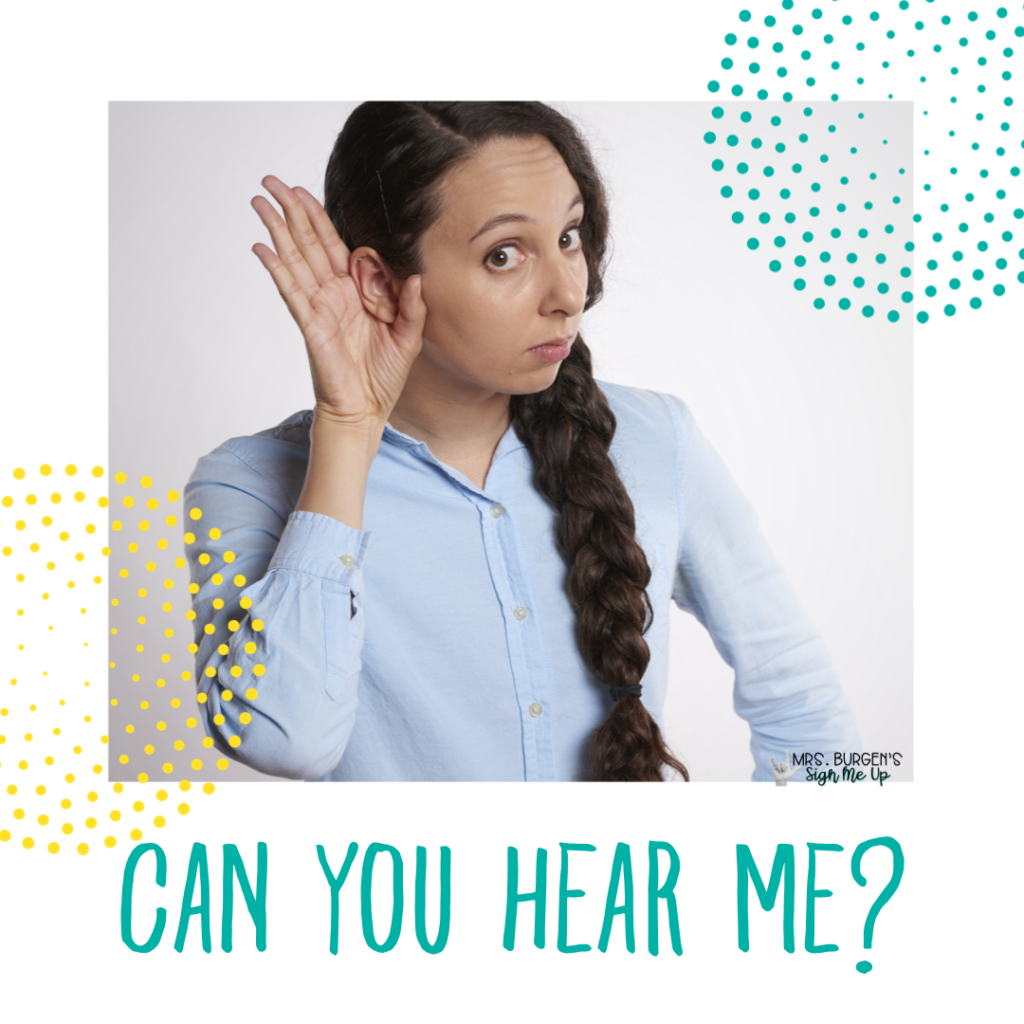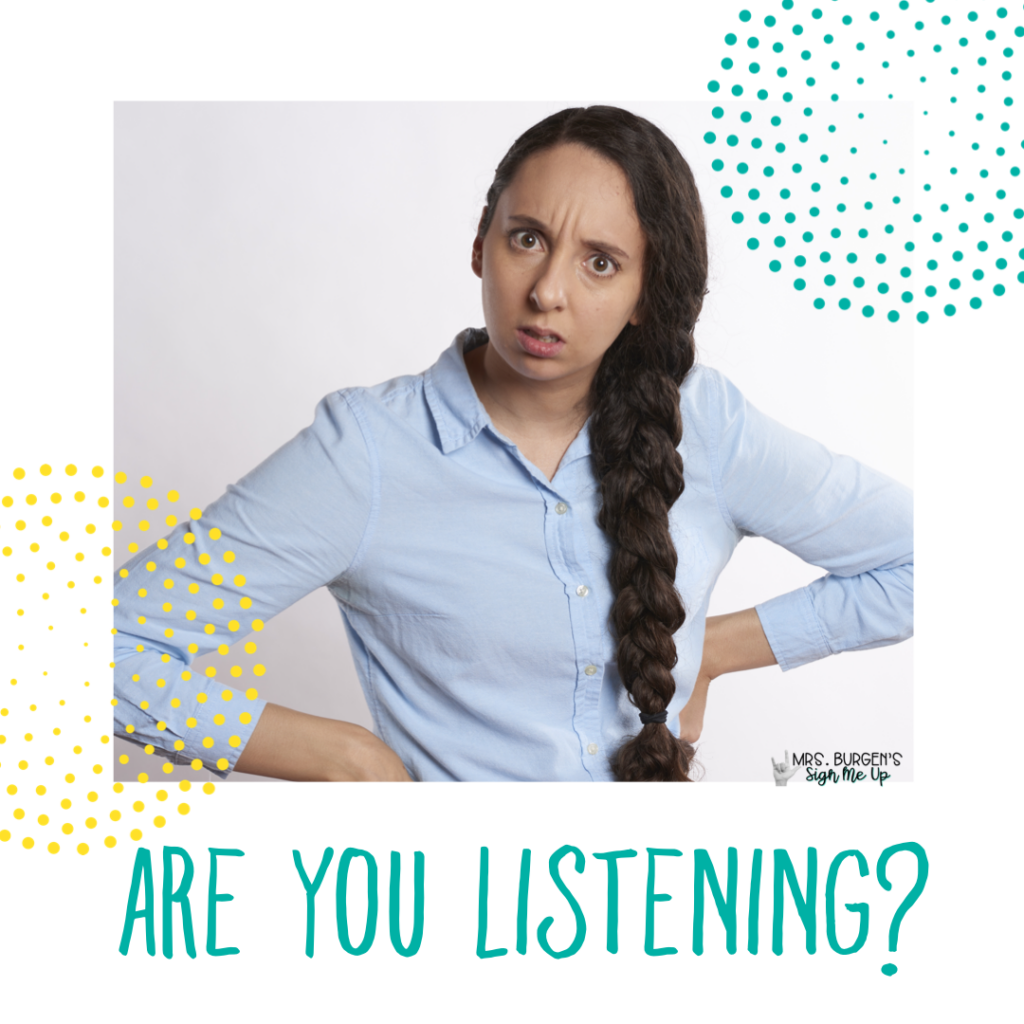Working with hard of hearing students
You can create a successful communication environment for the hard of hearing students in your classroom. When working with hard of hearing students who depend solely on auditory input for communication, it is essential to ensure they have the best access to auditory input, use active listening and advocacy skills and know when and where a communication breakdowns occur and how to fix them. Miscommunications happen. We are often quick to dismiss a miscommunication before really analyzing where the break down occurred.

Hear
Can the hard-of-hearing student physically hear everyone in the classroom environment?This includes the teacher, other students, technology speakers, computers, announcements etc.
Step one: check to make sure the student can indeed hear you. If they have technology to help them access sound be sure that there are frequent checks (at least once daily) to ensure the technology is working.
There are a variety of hearing loss configurations in which hearing aids could be used to give a student better access to speech sounds and language. A “hearing loss” could range anywhere from slight to severe and be bilateral (both ears) or unilateral (one sided). Take the time to talk to the student, parent, or teacher of the deaf to become familiar with the student’s hearing loss so you can understand the level of hearing that a student is able to access both with and without their aids.
Children are only prescribed hearing aids when they are necessary, they don’t need them sometimes and not at others. They should be worn at all times to gain the most benefit. Some exceptions may be in extremely loud environments such as gymnasiums or cafeterias. But be aware that without the hearing aids on and working, the student will have limited access to language and communication around them.
Hearing Aids
If your student wears hearing aids, be sure that you have procedures in place to ensure they are being used consistently. Check daily to make sure the student has his/her hearing aids ON. It does happen that students leave them in their backpack, on their desks, in pockets, etc.
Make sure the aid has a working battery and that the battery door is closed properly. If you are working with younger students, having a listening stethoscope and a battery tester are essentials.
Basic troubleshooting involves making sure the ear mold is secure so that there is no feedback. You can also check the tubing to ensure there are no cracks. If you have a student who sweats a lot after recess, you may want to keep a bag of rice or a drying box in the classroom to use in case you see moisture gathering in the tubing.
Cochlear Implants
A child with cochlear implants most likely has a severe to profound hearing loss. This means that without the use of the cochlear implant they have extremely limited access to sound. They are most likely able to to hear only loud environmental sounds and do not have access to speech sounds. Therefore, if the cochlear implants are not working, the student is at an extreme disadvantage as their access to spoken language has likely been lost.
Cochlear implants also have batteries. Often they are rechargeable but a simple ling test or conversation with your student can confirm the device is working. If your student has implants it would be best to keep an extra charger or batteries at school just in case it’s needed.
FM Systems
If your hard-of-hearing student has an FM or other microphone system, do a check at various times during the day to ensure the system is working and connected. Systems using bluetooth can spontaneously disconnect so it’s beneficial to plan some checks during the day. Take time at the beginning of the year to learn how the student connects to all the technology in the classroom. (remote mic, computers, ipads etc.)
Preferential seating
Is the student seated in an optimal acoustic environment? Preferential seating does not always mean front and center. Ideally, students should be seated close to the speaker, away from noisy distractions (open doors or windows, fans, heaters, projector fans, ticking clocks etc.) They should also be able to turn to see peers when they are speaking.

Listen
Does your hard of hearing student have ACTIVE listening skills. Even with hearing aids, cochlear implants and remote mic systems, the auditory input can be distorted and interrupted, so it is ESSENTIAL that students are able utilize active listening skills.
What is active listening?
Looking at the speaker and being able to incorporate facial cues, and body language to clarify speech. Please be aware, that if the speaker is wearing a mask, this will severely impact a student. The ability to put facial cues together with speech is important and missing the cues of the facial expression WILL impact a student’s ability to actively listen to what is being said.
There WILL be communication break downs. Does the student know how to navigate a situation when he/she did not hear or understand what was spoken? Have a conversation with your student and discuss some “quiet cues” for checking for understanding. Sometimes it’s a look in her or her direction, a thumbs up or down or a raised eyebrow. Try to avoid constantly calling the student out with ” Did you hear me? or Pay attention.”
Also be aware that there will be times when the student will not know that they have missed something. Frequent checks for understanding for key information will benefit everyone . Be aware that if there is background noise, it is likely that the student will miss information. As much as possible, avoid giving directions during transition times, and provide visual representations of essential information. Write assignments and key dates on the board or print out to give to the student.

Understand
This section is not unique to hard of hearing students but essential to discuss. Even with the best technology, it is likely that a student with hearing loss will have missed incidental conversation through out their lives. This can result in a limited or less than robust experience with vocabulary.
For example, children with normal hearing levels will hear parents, siblings and peers chatting on the phone, conversations in other rooms, conversations in the car, discussions with other adults at markets, stores, events etc.
A child with a hearing loss will likely miss the details of most of these indirect conversations. This also assuming you have a student that wears their technology ALL WAKING HOURS. If you have a student that takes frequent breaks from technology or didn’t start using technology consistently after age 3, they may be at even more of a disadvantage.
So, what is the point here? Never assume that student understands a new concept or vocabulary word. Always check in with your hard of hearing student to ensure they have understanding of the new topic or if they need further explanation. ( You can think of it similarly to if you were working with a student who’s first language is not English. ) The student with a hearing loss HAS DEFINITELY missed information at some point, but you won’t know where those gaps are unless you check in with them.

Apply
Do you notice the student applying the information in a way that demonstrates understanding? Is the student aware when they don’t understand the vocabulary or the concept? Are they asking relevant questions?
Ask questions to ensure that your students understand a new concept or an assignment. Instead of saying “did you hear me?” or “Repeat what I just said”, Try asking the student to share how they plan to start the assignment. What would be the first step, or the final step. Providing written directions or notes is also beneficial, so that the student can continually refer back to topic and steps necessary to complete an assignment.
Creating a successful environment for communication for your deaf and hard of hearing student in classroom is not difficult. Take the time to learn about your student and their specific listening needs. Set up your student for success by learning about their hearing loss, and working with them to determine the best strategies for active listening in your classroom environment.
Happy teaching!
Click the link below to print a copy to keep or share.


